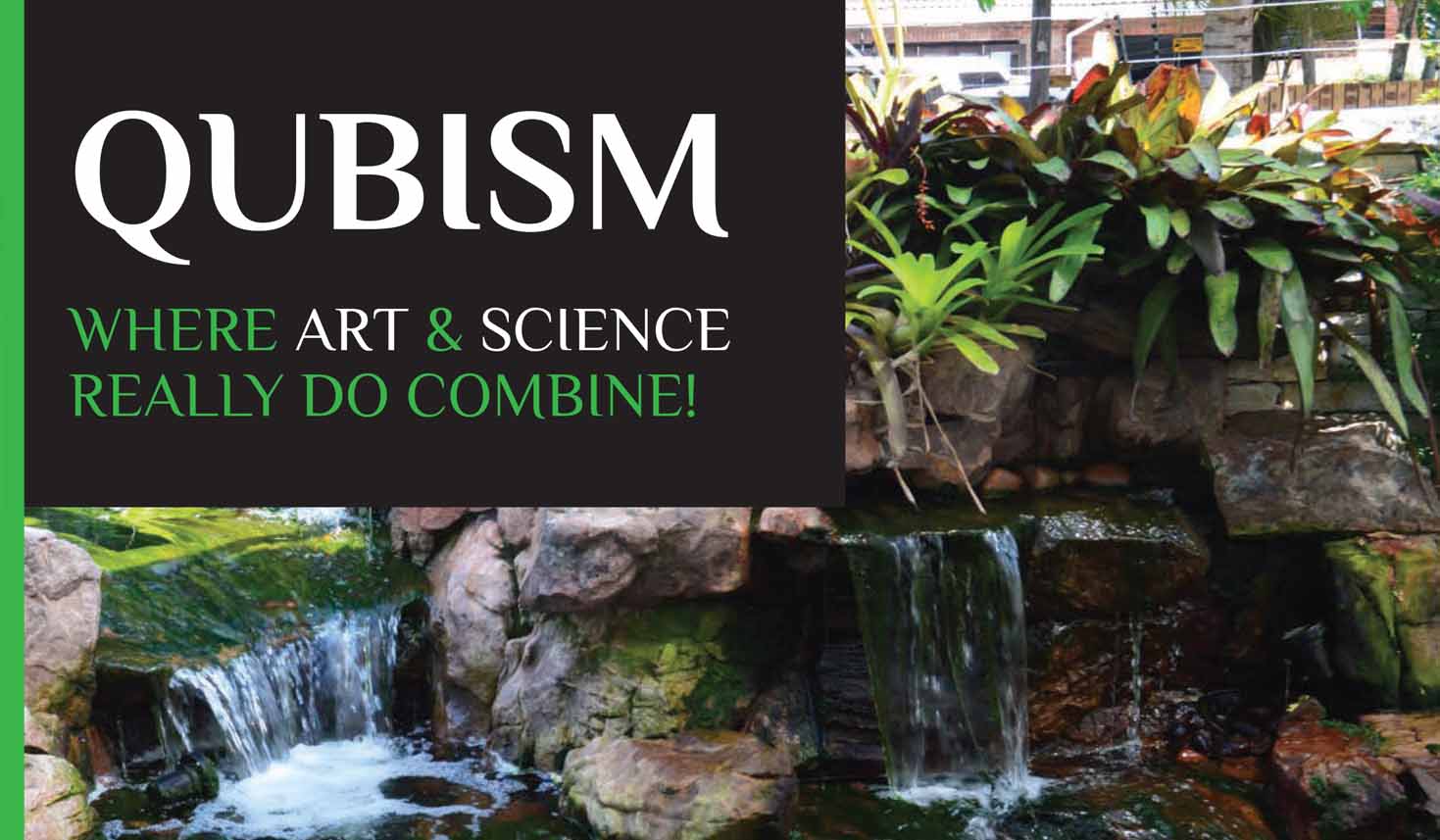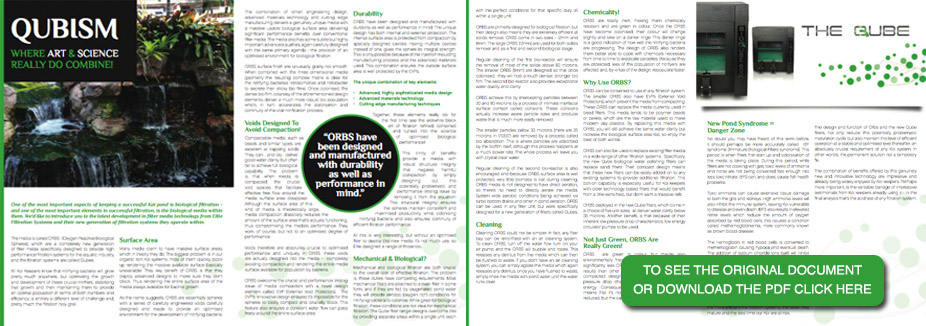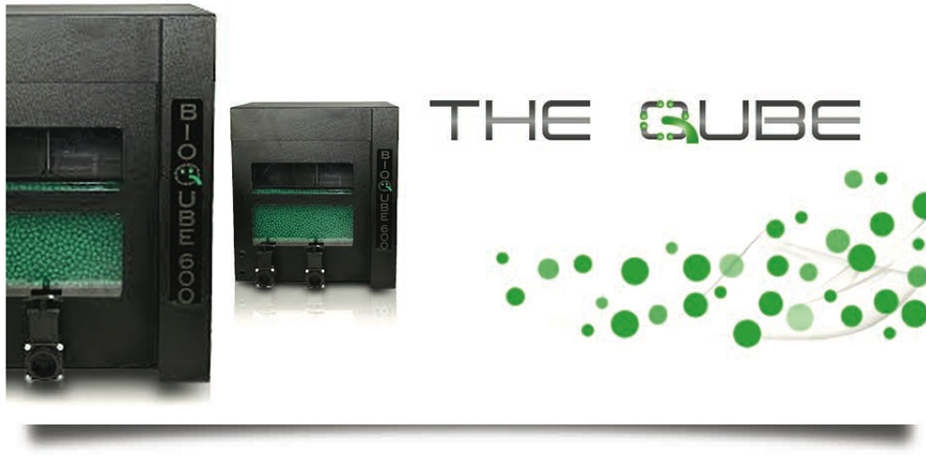Press
Qubism - Where Art & Science Really Do Combine!
Wednesday, May 07, 2014


One of the most important aspects of keeping a successful Koi pond is biological filtration - and one of the most important elements in successful filtration, is the biological media within them. We’d like to introduce you to the latest development in filter media technology from Elite Filtration Systems and their new generation of filtration systems they operate within.
The media is called ORBS - (Oxygen Reactive Biological Spheres), which are a completely new generation of filter media specifically designed to provide high performance filtration systems for the aquatic industry, and the filtration systems are called Qubes. All Koi Keepers know that nitrifying bacteria will grow pretty much anywhere, but optimising the growth and development of these crucial nitrifiers, stabilising that growth and then maintaining them to provide an optimal population in terms of both numbers and efficiency...is entirely a different level of challenge and, pretty much the filtration holy grail.
Surface Area
Many media claim to have massive surface areas, which in theory they do. The biggest problem is in our organic rich Koi systems, most of them quickly block up rendering the massive available surface basically unavailable! They key benefit of ORBS is that they deploy advanced designs to make sure they don’t block. Thus rendering the entire surface area of the media always available for bactria growth. As the name suggests, ORBS are essentially spheres with a series of carefully engineered voids carefully designed and made to provide an optimised environment for the development of nitrifying bacteria The combination of smart engineering design, advanced materials technology and cutting edge manufacturing delivers a genuinely unique media with a massive usable biological surface area delivering significant performance benefits over conventional filter media. The media also has some subtle but highly important advanced qualities, again carefully designed with the same primary agenda - the provision of an optimised environment for biological filtration. ORBS surface finish are, unusually, grainy not smooth. When combined with the three dimensional media geometry the resulting complex matrix is ideal for the nitrifying bacterias nitrosomonas and nitrobacter to secrete their sticky bio films. Once colonised, the dense bio-film, courtesy of the aforementioned design elements, deliver a much more robust bio population which, in turn, accelerates the stabilisation and continuity of the vital nitrification process.

Voids Designed To Avoid Complication!
Compactable media, such as beads and similar types, are excellent at trapping solids. They can, and do, deliver good water clarity, but often fail to achieve full biological capability. The problem is, that when media is compacted the crucial void spaces that facilitate effective free flow around the media surface area disappear. Although the surface area of this kind of media is theoretically large, media compaction drastically reduces theamount of the surface area that’s actually functioning, thus compromising the media’s performance. They work, of course, but not to an optimised degree of performance. Voids therefore are absolutley crucial to optimised performance and uniquely in ORBS, these voids are actually designed into the media - completely avoiding compaction and rendering the entire media surface available for population by bacteria. ORBS overcome the crucial and performance limiting issue of media compaction with a novel design element called EVP (External Void Protectors). The EVP’s innovative design ensures it’s impossible for the spheres to totally compact and, crucially, block. This feature also ensures a constant water flow can pass freely around the entire surface area.
Durability
ORBS have been designed and manufactured with durability as well as performance in mind. The unique design has both internal and external protection. The internal surface area is protected from compaction by specially designed cavities. Having multiple cavities instead of one, gives the sphere its integral strength. This is only possible because of the injection moulding manufacturing process and the advanced materials used. This combination ensures the outside surface area is well protected by the EVPs.
The unique combination of key elements:
- Advanced, highly sophisticated media design
- Advanced materials technology
- Cutting edge manufacturing techniques
EVPs Together these elements really do for the first time see the erstwhile black art of filtration refined, contained and turned into the science of optimised biological performance! This Trinity of benefits a media with robust structural integrity that negates harmful compaction by simply designing out this potentially problematic and performance limiting issue by removing it from the equation! This structural integrity ensures the spheres maintain consistent and maximised productivity while colonising nitrifying bacteria and also ensures continuity of efficient filtration performance. All this is very interesting, but without an optimised filter to deploy this new media it’s not much use, so Elite designed a range of those too.

Mechanical & Biological?
Mechanical and biological filtration are both crucial to the overall task of effective filtration. The problem is, these duties have competing requirements. Most mechanical filters are attached to a main filter in some form, and if they are fed by oxygenated pond water they will provide aerobic (oxygen rich) conditions for nitrifying bacteria to colonise. While great for biological filtration, these conditions are not ideal for mechanical filtration. The Qube filter range designs overcome this by providing separate areas within a single unit, each with the perfect conditions for that specific duty all within a single unit. ORBS are primarily designed for biological filtration, but their design also means they are extremely efficient at solids removal. ORBS come in two sizes - 12mm and 8mm. The large ORBS (12mm) are used for both solids removal and as a first and second biological stage. Regular cleaning of the first bio-reactor will ensure the removal of most of the solids above 80 microns. The smaller ORBS (8mm) are designed so that once colonised, they will host a much denser, stronger bio film. The second bio-reactor also provides exceptional water quality and clarity. ORBS achieve this by intercepting particles between 30 and 80 microns by a process of intimate interfacial surface contact called collisions. These collisions actually increase waste particle sizes and produce waste that is much more easily removed. The smaller particles below 30 microns (there are 25 microns in 1/1000”) are removed by a process called bio absorption. This is where particles are adsorbed by the biofilm itself, although this process happens at a much slower rate. The whole process will leave you with crystal clear water. Regular cleaning of the second bio-reactor is also encouraged and because ORBS surface area is well protected, very little biomass is lost during cleaning. ORBS media is not designed to have direct aeration, so there’s no need to directly aerate the media. System wide aerobic conditions being achieved via turbo bottom drains and other in-pond aeration. ORBS can be used in any filter unit, but were specifically designed for a new generation of filters called Qubes.
Cleaning
Cleaning ORBS could not be simpler. In fact, any filter bay can be retro-fitted with an air cleaning system. To clean ORBS, turn off the water flow, turn on your air pump and the ORBS will bubble and rotate. This releases any detritus from the media which can then be flushed to waste. If you don’t have an air cleaning system, you can simply agitate the media which again releases any detritus, once you have flushed to waste, simply rinse the media with pond water until the water runs clear.
Chemicality!
ORBS are totally inert, making them chemically resistant and are green in colour. Once the ORBS have become colonised, their colour will change slightly and take on a darker tinge. This darker tinge is a good indication of how well the nitrifying bacteria are progressing. The design of ORBS also renders them better able to cope with chemicals necessary from time to time to eradicate parasites. Because they are protected, less of the population of nitrifyers are affected and, by virtue of the design, repopulate faster.

Why Use Orbs?
ORBS can be converted to use in any filtration system. The smaller ORBS also have EVPs (External Void Protectors), which prevent the media from compacting. These ORBS can replace the media currently used in bead filters. This media tends to be polymer beads or pellets, which are the raw material used to make modern day plastics. By replacing this media with ORBS, you will still achieve the same water clarity but increase the biological surface area too, so enjoy the best of both worlds. ORBS can also be used to replace existing filter media in a wide range of other filtration systems. Specifically, the new Qube biological water polishing filters can replace sand filters. Their compact design means that these new filters can be easily added on to any existing systems to provide additional filtration. This bolt-on capability is especially useful for Koi keepers with older technology based filters that would benefit from a little extra help, but don’t want a massive refit. ORBS deployed in the new Qube filters, which come in a choice of five unit sizes, all deliver water clarity below 35 microns. Another benefit, is that because of their inherent low pressure drop characteristics, low energy circulator pumps to be used.
Not Just Green, ORBS Are Really Green!
ORBS are green in colour, but they’re also environmentally friendly because you need to use significantly less ORBS to achieve the same filtration results than other media. This, in turn, enables a compacted design which, combined to their low pressure drop characteristics, in turn require less energy. Consequently, these combined benefits means that it’s not just the system footprint that’s reduced, but the carbon one also.

New Pond Syndrone = Danger Zone
No doubt you may have heard of this term before, it should perhaps be more accurately called IBF syndrome. (Immature Biological Filters syndrome). This period is when filters first start up and colonisation of the media is taking place. During this period, while filters are not cooking with gas, toxic levels of ammonia and nitrite are not being converted fast enough into less toxic nitrate. IBFS can, and does, cause fish health problems. Toxic ammonia can cause extensive tissue damage to both the gills and kidneys. High ammonia levels will also inhibit the immune system, leaving Koi vulnerable to disease and even death. IBFS also results in elevated nitrite levels which reduce the amount of oxygen absorbed by red blood cells, this causes a condition called methemoglobinemia, more commonly known as brown blood disease. The Hemoglobin in red blood cells is converted to methemoglobin causing hypoxia and eventual death. The addition of sodium chloride ions (salt) will inhibit the uptake of methemoglobin reducing its toxicity, but that’s a fix not a solution - so filters need to establish an effective bio population as soon as possible. When this happens, IBFS recedes and nitrogenous waste is more effectively converted to nitrate. This is accomplished by the nitrifying bacteria Nitrosomonas and Nitrobacter, we know this as the Nitrogen Cycle. All this of course is a function of filtration efficiency - the more efficient the filtration systems, the faster they mature and the less time our Koi are at risk. The design and function of Orbs and the new Qube filters, not only reduce this potentially problematic maturation cycle, but also maintain this level of efficient operation at a stable and optimised level thereafter, an absolutely crucial requirement of any Koi system. In other worlds, the permanent solution not a temporary fix. The combination of benefits offered by this genuinely new and innovative technology are impressive and already being widely enjoyed by Koi keepers. Perhaps more important, is the veritable barrage of impressive testimonials from Koi keepers already using it - in the final analysis that’s the acid test of any filtration system.
